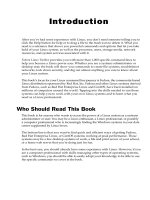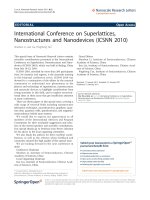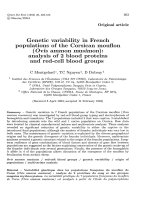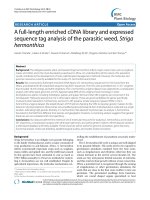Full conference+proceedings mekong,+salween+and+red+rivers+2016
Bạn đang xem bản rút gọn của tài liệu. Xem và tải ngay bản đầy đủ của tài liệu tại đây (16.55 MB, 989 trang )
International Conference on the Mekong,
Salween and Red Rivers: Sharing Knowledge
and Perspectives Across Borders
12th November 2016
Faculty of Political Science, Chulalongkorn University
Bangkok, Thailand
International Conference on the Mekong, Salween and Red Rivers:
Sharing Knowledge and Perspectives Across Borders
12th November 2016
Faculty of Political Science, Chulalongkorn University,
Co-organized by:
Center for Social Development Studies (CSDS), and
MA in International Development Studies (MAIDS)
Faculty of Political Science, Chulalongkorn University
Mekong Sub-region Social Research Centre (MSSRC),
Ubon Ratchathani University
Vietnam Academy of Water Resources (VAWR)
Supported by:
Australian Aid
CGIAR Research Program on Water, Land and Ecosystems: Greater Mekong
Copyright ©2016, the authors
All rights reserved.
No part of this publication may be reproduced, stored in a retrieval system, or
transmitted in any form or by any means, electronic, mechanical, photocopying,
recording or otherwise, without mentioning both the author(s) and co-organizers
mentioned above.
Cover design and layout by: Orapan Pratomlek
Cover image by: Carl Middleton, PhD.
Preface
Water resources are inextricably linked to local livelihoods and wellbeing,
agricultural production and food security, and local and as well as regional
national economies across the Mekong region. The Mekong, Red and Salween
Rivers are all transboundary rivers that are subject to the dynamics of rapid
change as the region increasingly integrates economically and socially. Whether
development is inclusive, informed and accountable, and the rights and
entitlements of marginalized communities recognized, remains a key challenge.
To strengthen governance and increase the likelihood of sustainable and fair
decisions, over the past fifteen years a number of research fellowship programs
have been undertaken across the Mekong Region. Since April 2015, the Center
for Social Development Studies (CSDS) of Chulalongkorn University, the
Mekong Sub-region Social Research Center (MSSRC)of Ubon Ratchathani
University, and the Vietnam Academy of Water Resources (VAWR) have been
running three WLE Greater Mekong fellowship programs in the Salween,
Mekong and Red River basins respectively for a total of 38 fellows. Each fellow,
partnered with a mentor, has undertaken an 18-month research project, whilst
also joining three collaborative workshops on research design, fieldwork
methods, and paper writing.
The “International Conference on the Mekong, Salween and Red Rivers: Sharing
Knowledge and Perspectives Across Borders”, held in the Faculty of Political
Science, Chulalongkorn University, was organized as a venue for the fellows to
share their findings. There was also the opportunity to interact with other
research fellows under programs organized by the Center for Khmer Studies on
the Food-Water-Energy Nexus in the Mekong Region; and a fellowship program
implemented by the UNESCO-IHA in the Ayrewaddy basin.
i
To organize the conference, as well as the wider fellowship program, has taken
the significant effort and commitment of many organizations and individuals. We
would like to thank:
The CGIAR Research Program on Water, Land and Ecosystems Greater
Mekong
program
(Kim
Geheb;
David
Clayton;
Rattamanee
Laohapensang; Mayvong Sayatham), and the Australian Department of
Foreign Affairs and Trade (Rachel Jolly; John Dore) for their financial
support for the international conference and the fellowship program, as
well as their broader support in implementing the fellowship program.
Dr. Pirongrong Ramasoota, Vice President of Chulalongkorn University,
Dr. Ake Tangsupvattana, Dean of Faculty of Political Science,
Chulalongkorn University, and Dr. Kim Geheb, WLE Greater Mekong
Regional Coordinator for offering opening remarks at the conference.
Dr. Babette Resurreccion of the Stockholm Environment Institute for
her keynote address: “Gender and water governance across the Mekong
Region: Challenges and Prospects”.
The mentors for the research fellows, namely: for the Salween River,
Asst. Prof. Dr. Carl Nigel Middleton, Vanessa Lamb, Prof. Dr. Chantana
Wungaeo, Prof. Dr. Jakkrit Sangkhamanee, Mr. Michael R. Medley, Dr.
Lyu Xing, Dr. Diana Suhardiman, and Mr. Jeff Rutherford; for the
Mekong River, Mr. Michael Simon, Mr. Louis Lebel, Mr. Albert
Salamanca, Asst. Prof. Dr. Carl Nigel Middleton, Dr. Diana Suhardiman,
Asst. Prof. Dr Kanokwan Manorom, Tubtim Tubtim, Chu Thai Hoanh,
Mr. Kim Geheb, Babette Resurrecion, Nguyen Ngoc Thuy and Mia
Urbano; and for the Red River: Prof. Dao TrongTu, Prof. Bui Cong
Quang, Prof. Nguyen Tung Hoa,
Dr. Do Hoai Nam, Dr. Nguyen Thi
Anh Tuyet and Mrs. Alexandra Nauditt.
The project coordinators, namely: Ms. Orapan Pratomlek (Salween
River); Ms. Chawirakan Nomai (Mekong River); and Mr. Ha Hai Duong
and Huy Hoang Bach (Red River).
The English editors who worked with the fellows in finalizing their
conference papers, namely: Mrs. Claudine Claridad Tanvir (Salween
ii
River); Simon Ross (Mekong River); and Prof. Bui Cong Quang (Red
River).
We would like to also thank all of the panel chairs and discussants, who are
identified in the subsequent pages.
The organizations hosting the fellowship programs believe that the important
contribution that research can and should make towards ensuring inclusive,
sustainable and fair development in the Mekong Region should not be
underestimated. Hence, fellowship programs serve a number of purposes,
including supporting researchers to build their skills, help them network across
the region, and ultimately to produce knowledge and share perspectives that is a
valuable contribution towards society. We consider that the conference papers
included in these proceedings are a useful contribution towards attaining these
goals.
On behalf of the organizers:
Asst. Prof. Dr. Carl
Asst. Prof. Dr Kanokwan
Assoc. Prof. Dr Nguyen
Middleton
Manorom
Tung Phong
Director
Director
Deputy Director General
Center for Social
Mekong Sub-region
Development Studies
Social Research
Ubon Ratchathani
Vietnam Academy for
Center
University
Resources
Chulalongkorn
University
iii
Contents
Preface
i
1. Differences in Women’s and Men’s Employment
2
in Hydropower Resettlement Areas: Some Gender
Perspectives
Zhong Mei
2. Nujiang Hydropower Construction: Blessing or Curse
15
for Lisu Women?
Huang Yaping
3. Saving the “last” River in China: An Intersectional Feminist
32
Analysis of the Campaign to Stop the Nujiang Dams Project
Hannah Nakaddy
4. Demand and Supply Factors Affecting Participation
60
in Hydropower Management in the Song Tranh 2
Hydropower Project
Le Thi Huong Loan, Pham Phuong Trung, and Truong Chi Hieu
5. Possible Socioeconomic Consequence of Hydropower Dams
83
on Downstream Communities: A Case of Hatgyi Dam
Kyaw Thu Han
6. Fragmented Sovereignty and the Politics of Watershed
Resources in the Shan State of Myanmar
K. B. Robert
106
7. From Wild Capture Fisheries to Fish Cages: Intimate
136
Water Governance in the Lower Songkhram River Basin
Soimart Rungmanee
8. Responses to Compensation Affected by the Son La
160
Hydropower Resettlement in Northwestern Vietnam
Pham Van Dung
9. Local Knowledge Amongst Farming Communities
179
on Response to Water Induces Hazards: Case Study in
Xuan Thuy National Park
Nguyen Thi Hong Lam
10. Mining Investment, Resource Governance, and Livelihood
197
Changes in Pek District Xieng Khouang Province, Laos
Oulavanh Keovilignavong
11. Rationale for Implementing the Irrigation Management
231
Transfer That Aim to Improve Efficiency of Water Supply
and River’s Health Case Study: Red River Delta
Nguyen Duc Viet
12. Masculinization of Agriculture in the Vietnamese
Mekong River Delta: The Power of Migration and
Remittance Investment on Adoption of Sustainable
Production Practice
Jenny Lovell
251
13. The Coping Strategies of Coffee Farmers in Response
273
to Water Scarcity: A Case Study of Ethnic Groups in the
Central Highlands of Vietnam
Nguyen Phuong Le
14. Implications on Women’s Lives and Livelihoods:
308
A Case Study of Villages to Be Affected by the
Mongton Dam Project in Shan State
Hnin Wut Yee
15. Ecofeminism Evolution: Political Openness and
340
Readiness of Gender Evolution in the Case of
Mong Ton Dam Project
Nang Shining
16. What Are the Challenges and Development Spaces
366
for Women and Men If the Sambor Hydropower Dam
Is Developed?
Suon Siny
17. Livelihood Development and Local Participation
400
in Fisheries Management in the Lower Mekong Basin (LMB):
A Comparative Study of Ethnic Groups in Laos and Cambodia
Serey Sok and Somkhit Boulidam
18. Research and Proposal on the Irrigation Modernization
Framework in Red River Delta, Vietnam
Vu Hai Nam
429
19. Impacts of the Irrigation Service Fee Policy
456
on On-farm Irrigation Management, Agriculture
Productivity and Household Economy
Le Van Chinh
20. Urban Landscape Dynamic Analysis on
472
Mandalay City, Myanmar
Kyaw Zaya Htun, Swe Swe Aye, Noravan Cauwenbergh,
and William Veerbeek
21. The Role of Environmental Impact Assessment in
489
the Governance of Nu-Salween River: A Comparative Study
of the Chinese and Myanmar Approaches
Bian Yongmin
22. Water Quality Management for Sustainable Aquaculture
515
Production in the Mekong Delta
Nguyen Thi Hai Ninh, Nguyen Mau Dung, and Ho Ngoc Cuong
23. Assessing the Capacity of Receiving Wastewater of River
546
for Decision Support on Water Resources Protection Case Study:
Thuong River
Trinh Thi Thu Van and Bui Cong Quangba
24. On the Application of Agent-based Model on Water Allocation
570
to Improve Water Usage Efficiency and Reduce Conflict
Tran Duc Trinh
25. Mekong River-based Livelihood Strategies of Women
in Don Sahong Village, Champasack Province Southern Laos
Minitta Taosouvanh
585
26. The Women’s Role in Agriculture and Irrigation Management:
615
A Case Study at Gia Xuyen Commune, Gia Loc District
in Hai Duong Province, Vietnam
Le Thi Hong Nhung
27. Gender Roles and Participation Benefits for Women
634
in the Payment for Forest Environmental Services Program
in Quang Nam Province, Vietnam
Nguyen Bich Ngoc, Pham Huu Ty, and Nguyen Cao Sang
28. Vulnerability and Adaptation to Drought of Ethnic Minority
671
Women in the Krong No River Basin, Vietnam
Nguyen Thi Da Thao, Hoang Dung Ha, Pham Thi Nhung,
and Tran Thi Tra Giang
29. Evaluation of Mangrove Ecosystem Services
700
in the Ayeyarwady Delta: A Step Towards Integrated
Coastal Zone Management in Myanmar
Swuam Pyaye Aye Aung, Hitke Htike, and Noravan Cauwenbergh
30. Assessing Potential Threats to Fisheries and Socio-economy
713
at Thanlwin Estuary
Cherry Aung
31. Rights and Rites for Water Justice: A Case Study
of the Proposed Hatgyi Dam on the Salween River
Saw John Bright
732
32. Ethnobotanical Study on Some Plants Growing
766
Along the Thanlwin River in Lashio District,
Northern Shan State, Myanmar
Mar Mar Aye
33. Geographical Analysis on the Impact of Land Cover
797
Changes on Socio-economic Conditions in Bawlakhe District,
Kayah State in Myanmar: A Case Study of Four Villages
Khin Sandar Aye
34. Concepts for the Modernization of Water Management
827
in the Bac Hung Hai Irrigation System
Dong Xuan Nghia
35. Community-based Water Quality Monitoring: A Multi-benefit
873
Approach to Water Governance in The Red River Basin, Vietnam
Nguyen Van Huy
36. Institutional Situation and Proposals for Improving
887
Drought Management for Red River Delta, Vietnam
Nguyen Xuan Lam
37. Assessment of Climate Change Impact on River Flow Regimes
907
to Support Decision-making in Water Resources Management in the
Red River Delta, Vietnam: A Case Study of Nhue-day River Basin
Phan Cao Duong
38. Improvement of On-farm Management for Effective
Use of Water Resource From Small-scale Irrigation Schemes
in Northern Mountainous Areas in Red River Basin
Pham Thi Phuong Thao
934
39. The Absence of Women’s Role in Hua Na Dam
Rehabilitation Projects in Ban Nong Ong Village,
Si Saket Province, Thailand
Surasom Krisanachuta, Saowanee T. Alexander,
Pinwadee Srisupan, and Thitarat Phanchana
953
International Conference on the Mekong, Salween and Red Rivers: Sharing Knowledge and
Perspectives Across Borders|Faculty of Political Science, Chulalongkorn University | 12th November 2016
Gender, Dams and Social Justice
Chair: Kanokwan Manorom
Discussant: Babette Resurreccion
Presented by
Zhong Mei
Huang Yaping
Hannah Nakaddy
1
International Conference on the Mekong, Salween and Red Rivers: Sharing Knowledge and
Perspectives Across Borders | Faculty of Political Science, Chulalongkorn University | 12th November 2016
Differences in Women’s and Men’s Employment in
Hydropower Resettlement Areas: Some Gender
Perspectives
Zhong Mei
Graduate Student,GMS Study
Greater Mekong Sub-regional
Study Center (GMSSC) of Yunnan University,China
Email:
Abstract
Gender-related issues figure high on the global research and policy agenda
especially economic issues such as employment and inequity between men and
women. My research focuses on the gender situation in employment practices in
hydropower resettlement areas in Liuku Town of Yunnan Province. My research
also affords comparisons between the situation of men and women in terms of
their life before and after resettlement, differences in opportunities for
employment, and the changes in social division of labor. Through comparing
these factors, my research explores and explains the reasons for the differences
between women’s and men’s employment situation and offers recommendations
to restore gender equity in employment. A number of factors affect employment
and resettlement in the reservoir area including national policy, men’s and
women’s education situation, and marital status. The research offers a better
understanding of the ongoing changes in women’s employment and provides
methods to bridge the employment differences between men and women. The
research results are expected to be useful for local women or people to increase
their understanding of the employment opportunities and skills required in the
resettlement areas.
2
International Conference on the Mekong, Salween and Red Rivers: Sharing Knowledge and
Perspectives Across Borders | Faculty of Political Science, Chulalongkorn University | 12th November 2016
Introduction
My research focuses on the resettlement area village called Xiao Shaba that has
been built for the planned Liuku hydropower project in Liuku Town, Nujiang
Lisu Autonomous Prefecture of Yunnan Province. The research aims to analyze
the employment differences between men and women in Xiao Shaba. Liuku
Town hosts the seat of Nujiang Prefecture’s government, and is located across
the Gaoligong Mountains, East of Myanmar, South of Lu Zhang Town, and
North of Shangjiang Township. The town is surrounded by high mountains,
deep valleys, and steep ravines (see Figures 1 and 2).
Figure1. Liuku Town surrounded by high mountains
Figure2. Liuku Town surrounded by deep gorges
3
International Conference on the Mekong, Salween and Red Rivers: Sharing Knowledge and
Perspectives Across Borders | Faculty of Political Science, Chulalongkorn University | 12th November 2016
Hydropower development in this area is influenced by issues of reservoir
resettlement, especially the lack of employment opportunity in the reservoir
resettlement area. It is increasingly important to solve the issue of hydropower
resettlement so that people resettled by the dam can benefit from hydropower
development. Once I had finished my field trip in Nujiang Liuku, I realized that
the Liuku hydropower station hasn’t been built yet. However, the reservoir
resettlement has been completed. Moreover, resettlement has a lot of impacts on
local people’s employment situation and is a key point of gender inequality. It is
worth exploring what factors impact on employment, and among these impacts,
what are the key differences between men and women.
My research will identify the gaps in employment opportunity between men and
women. Then, it will identify the related causes of gender inequity in terms of
employment opportunity. The results could contribute to raising the awareness of
the affected people in the reservoir resettlement area especially about the role of
women. My research emphasizes the changes in employment situation and
prospects after resettlement, and compares the income of people before and after
resettlement. This also provides an understanding of the changes in income
structure and comparisons between men and women, including their life situation
before and after resettlement, differences in employment opportunity, and the
changes in social division of labor. My research aims to show that gender
inequality if a pressing concern in the resettlement areas in the context of the
women themselves, present policy constraints and societal norms, and that the
gender inequality in employment needs to be urgently and effectively addressed.
Methodology
This study’s methodology is based on a qualitative approach. Drawing from a
literature review, I frame my research using “Rights” and “Rites” as analytical
concepts to understand how decision-making processes take place and can be
strengthened. The data collection was undertaken at two levels: at the
national/state level; and at the village/community level. Methods include studies.
4
International Conference on the Mekong, Salween and Red Rivers: Sharing Knowledge and
Perspectives Across Borders | Faculty of Political Science, Chulalongkorn University | 12th November 2016
This was done with the aim of getting the Liuku Hydropower reservoir
resettlement’s original employment data and reports, and data of re-employment
before and after resettlement to get an overview of the work and employment
situation in the resettlement area. The field research consisted of household
questionnaires, focus group discussions and extensive interviews with the
affected local residents, village heads and local officials in order, focusing on
work and employment issues.
I did a field survey in October in Nujiang Liuku to get more information about
the situation of resettlement and employment. This consisted of the following
activities:
1. Structured interview with experts: This structured interview was a
household survey interview with households to get a general
understanding of affected local people’s job conditions and incomes,
especially women’s job conditions. I interviewed four government
officials: the minister and vice-minister of Immigration in Lushui County,
and two deputy directors of Immigration of Nujiang Autonomous
Prefecture.
2. Semi-structured interviews with local people: this involved interviews
with local officials and village heads to get information related to the
effect of hydropower station’s resettlement project on local people’s
livelihoods, and the situation of women’s employment. In my field trip, I
interviewed the leaders of three groups in Xiao Shaba to get an
understanding of the resettlement plan.
3. Survey questionnaire: The survey included 30 people (15 men: 5 people
over 60 years old, 8 people between 40-60 years old, 2 people between
20-40 years old; 15 women: 2 people over 60 years old, 8 people between
40-60 years old, 5 people between 20-40 years old).
4. I interviewed five shop owners (employers in Xiao Shaba Building
Materials Market).
5. Focus group discussions: This was used to discuss key issues about
employment and to get the perspectives of men and women in the
resettled communities. I interviewed 15 households in Xiao Shaba village
5
International Conference on the Mekong, Salween and Red Rivers: Sharing Knowledge and
Perspectives Across Borders | Faculty of Political Science, Chulalongkorn University | 12th November 2016
to get information about the influence of resettlement and the
employment situation.
These steps were accompanied by discussions with my mentor and designing the
initial research questions and identifying key informants for interviews. This
process allowed me to get a deeper understanding: of the background of
immigration in Xiao Shaba Village, the employment situation before and after
immigration and resettlement. In addition, I could also make a before and after
comparison in relation to income sources, income structure, and the change to
the community way of life.
My last step was data analysis and report writing using the research investigation
and materials. Data was analyzed to see whether men’s and women’s work
employment was equal, to explore the gender-based factors affecting inequality in
employment, and how to solve the gender differences in employment
opportunities.
Results
a. The general situation of Xiao Sha New Village
There are three groups in the Xiao Shaba resettlement area. The three groups
have in total 170 households, 1,069 people in total (from official statistics in
November 2014). There are 268 women and 801 men. The main ethnicity is Lisu,
with a small number of ethnic Bai people. The local government designed and
built two layers of house per household for the resettled people in Xiao Shaba
(see Figures 3 and 4).
In addition, the local government moved the old building materials market nearer
to the Xiao Shaba New Village (Figure 5). However, several storekeepers in the
building materials market state that, nowadays, the local economy and the
building materials business was not so good, hence the workers’ wages were also
low.
6
International Conference on the Mekong, Salween and Red Rivers: Sharing Knowledge and
Perspectives Across Borders | Faculty of Political Science, Chulalongkorn University | 12th November 2016
Figure 3: Houses in the resettlement area of Xiao Shaba New Village
Figure 4: Houses and shops in the resettlement area of Xiao Shaba New
Village
Figure 5: The building materials market in its new location
7
International Conference on the Mekong, Salween and Red Rivers: Sharing Knowledge and
Perspectives Across Borders | Faculty of Political Science, Chulalongkorn University | 12th November 2016
b. Changes in social division of labor
Xiao Shaba Village (now called Xiao Shaba New Village) is a typical mountain
farming village in Yunnan Province similar to other rural mountainous areas. The
village livelihoods consist of traditional farming and livestock raising as the main
source of food, income and economic activity. The men are responsible for the
fields and heavy manual labor while women are responsible for livestock and
housework. But with the development of China's new economic development
policies and the increased support for infrastructure construction in Yunnan
Province, while the traditional "male" role has not fundamentally changed, the
traditional division of labor has changed to a certain extent. The stronger males
tend to seek employment outside the village and many families now employ
outside labor.
When Xiao Shaba was transformed into Xiao Shaba New Village, combined with
the local government planning and support, a new social division of lab our and
employment between men and women began to emerge. Firstly, the new rural building
materials market next to the new village accommodated part of the surplus labor force
(mainly middle-aged and older men and women). Secondly, as a result of the rezoning of
the original village land during the resettlement process, most of the villagers were
provided land elsewhere as compensation along with some funds for the transfer of
land. Only a few villagers have arable land to engage in a small amount of farming
mainly of corn and potatoes, and some raise cattle. Thirdly, due to the development of
local transportation, a few women have taken up the work of transporting passengers
and goods. A few women who have cash available have even bought vans for the
transport business. But most of the local women work as porters in the nearby building
materials market or get various jobs as paid labor. In sum, women no longer need to stay
at home as they have an opportunity to find work outside. For the men, they have
continued their role of seeking employment outside the village for cash income. In this
respect, both men and women to some extent have an equal chance of finding jobs (see
Figures 6 and 7).
8
International Conference on the Mekong, Salween and Red Rivers: Sharing Knowledge and
Perspectives Across Borders | Faculty of Political Science, Chulalongkorn University | 12th November 2016
Figure 6: Women working as porters
Figure 7: Women at work in the resettlement area
c. Different incomes on gender
The different degree of social resources which men and women possess makes
the difference in terms of the income they can generate. There are some reasons
as follows: One, the pressure and influence of traditional concept of marriage
limits the role of women to that of a housewife who takes care of the home,
children and family. Two, the traditional division of labor and social
arrangements between men and women mean that men are more readily accepted
when they go find work outside the village, leading to inequality in employment
opportunities for women. This further implies that women also get less
opportunity to learn or further their skills for work outside their village. In the
9
International Conference on the Mekong, Salween and Red Rivers: Sharing Knowledge and
Perspectives Across Borders | Faculty of Political Science, Chulalongkorn University | 12th November 2016
traditional division of men and women, women must be responsible for
housework and especially taking care of the older people and children so they
often have no spare time or energy to go find and work outside. For men, they
can be around the village during the busy farming season and then leave to find
work outside.
Both the source and amount of income became further gender-differentiated
after the government built new houses for the Xiao Shaba villagers for
resettlement and also moved the original building materials market to the Xiao
Shaba New Village. The government’s aim was to provide employment
opportunities for the resettled villagers. Some of the villagers who have their
houses located near the building materials market could rent the ground floor of
their house to the market shopkeepers as a store front. A part of the income for
these villagers thus comes from rentals. The rest of the non-rental houses can get
a certain amount every year as housing compensation from the government. But
overall, villagers’ incomes have now increased compared to previously since a lot
more people can find jobs and get income outside the village. For example, the
average annual income previously in the village was about 6,000 CNY
(approximately 870 USD). Now in 2015, it has increased to around 10,000 CNY
(approximately 1450 USD). Some families also send their children to find odd
jobs to get money.
d. Women’s livelihoods and employment opportunity in the
reservoir resettlement area
Xiao Shaba New Village was built based on a pilot project for new rural
construction in Yunnan province as part of the government’s poverty alleviation
projects. Thus this cannot be viewed only as a reservoir resettlement project,
although the resettlement plans are related to the construction of the hydropower
project. While the living condition of the villages has improved compared
previously due to better housing and employment opportunities, there is still a
difference among families and individuals. Those who can afford the time and
energy to work often get more opportunities to find work in the town, while
women who are not able to do so for various reasons including family and other
10
International Conference on the Mekong, Salween and Red Rivers: Sharing Knowledge and
Perspectives Across Borders | Faculty of Political Science, Chulalongkorn University | 12th November 2016
commitments or those who prefer a life of leisure rather than extra work, do not
go seek outside employment.
Discussion
a. Social norms limit women’s employment opportunities
The traditional marriage concept is a key limiting factor that constrains women’s
outside employment opportunities. When a woman gets married, she needs to
move to her in-laws’ home. The newly-married women also face more pressure
than men to take on the responsibilities of taking care of the home and family.
After getting married, women also find their social circles get smaller as they have
little time other than for taking care of their homes and families. They also find
that when they were transferred from their previous living environment to a new
environment with their husbands that it requires a period of time to adapt
psychologically to the changes. Many newly-married women therefore often don't
wish to go out looking for a job immediately after getting married.
The influence of life concept means that for many women, it is adequate to just
enjoy “living in today.” These women enjoy the comforts of family life in which
they need to do nothing else but take care of their children and elders, and spend
time entertaining their friends. For these women, it is a question of: “Why do I
need to go outside to find a job when my husband can feed me?”
In daily life, most people have no desire or opportunity to pursue better quality
life by getting more material things, but are content with getting their daily needs
met. Only those who have an opportunity or desire to improve their life tend to
go outside to look for work or to study. In Xiao Shaba New Village, some
middle-aged women often stay at home, are also not working outside, just
drinking tea or wine, chatting, playing mahjong together with their friends or
neighbors, and occasionally do some handworks (but these handworks are more
to with their use in the home; they do not go outside to sell). I had some
interviews with local women who worked at the building material market, and got
11
International Conference on the Mekong, Salween and Red Rivers: Sharing Knowledge and
Perspectives Across Borders | Faculty of Political Science, Chulalongkorn University | 12th November 2016
information about the situation of themselves, their employment and daily life.
The educational level attained by most of the local women, especially married or
middle-aged women, are not too high, some have just completed grade school.
As for the reason, most of the answers are that they don't like to learn, while a
few families can’t afford the fees of education in the past. And there is nothing to
pursue more for them; what they pursue is enough for nothing more than to
marry and have children.
b. Resettlement
planning
and
women’s
employment
opportunities
As mentioned earlier, as part of the resettlement plans, the government agencies
in Xiao Shaba Village have moved the building materials market to the new
resettlement area village of Xiao Shaba to help people find employment and
income. In addition, Xiao Shaba New-village is nearer Liuku Town and can take
advantage of the city’s transport facilities and infrastructure.
In addition, the government agencies have also built school infrastructure such as
kindergarten and elementary schools in the resettlement areas to improve their
access to educational opportunities. These schools also give local women with
the required qualification opportunities to find teaching jobs as well as casual
labor for older women. But since there are not many of these jobs, it doesn’t
provide an effective solution for women to find employment.
Conclusion and Synthesis
At present, gender equity is a serious concern in terms of employment disparities
between men and women in the new resettlement. The issue of gender inequity
in employment can be addressed by state employment and infrastructure policies
as well as education and skills development. The development and expansion of
the local economies also has a positive impact on the overall employment
situation. In the resettlement areas, given the lack of farming land, the number of
12









